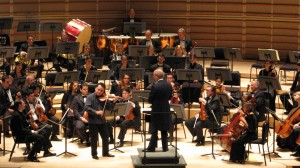
MISO closes season with bedrock “B’s”
When classical musicians return to first principles, they return to the music of “The 3 Great B’s”: J.S. Bach, Ludwig van Beethoven and Johannes Brahms.
The first two are more fundamental to the Western classical canon than Brahms, but the German Romantic remains one of the most frequently performed of all composers (though mostly for his instrumental music rather than his huge vocal output).
Friday night, the Miami Symphony Orchestra ends its current season with the music of the three composers, starting with one of Leopold Stokowski’s transcriptions of a Bach organ work — in this case the monumental “Passacaglia and Fugue” in C minor (BWV 582). These transcriptions were very popular with audiences in the middle years of the 20th century (you can hear one on the soundtrack to Fantasia, for example), but they fell out of favor with the rise of the Baroque performance-practice movement, which frowned on late-Romantic expansions of this literature.
Lately, though, these arrangements are making something of a comeback, and it seems that programmers feel audiences can enjoy them for what they are without wishing they were performances of the pieces as originally written. The “Passacaglia” must have made a tremendous impression on listeners of the early 18th century in any case, and Stokowski’s orchestration reflects that grandeur.
The program also includes the “Triple Concerto of Beethoven” (in C, Op. 56), a beautiful and fascinating work that for some reason is not as beloved by presenters as the composer’s five piano concertos or the great “Violin Concerto.” But it is a rewarding piece, with a gorgeous slow movement, and demonstrates how effectively Beethoven could meld a piano trio with an orchestra.
Soloists in the “Triple Concerto” are pianist Ciro Fodere, violinist Anne Chicheportiche and cellist Katinka Kleijn. The France-born Chicheportiche is a member of the orchestra; Fodere, a native of Uruguay, teaches at the New World School of the Arts; and the Dutch-born Kleijn is a member of the Chicago Symphony as well as of a progressive-metal band called District 97.
The concert closes with the “Symphony No. 3” (in F, Op. 90) of Brahms. This is one of Brahms’ best pieces — a powerful work with a sunny, expansive opening movement followed by a sweet, pastoral andante developed with considerable complexity.
The third movement, where one might expect to find a dance piece, is instead a bittersweet quasi-waltz with a lovely tune that is one of the composer’s most familiar. The symphony’s finale begins in mysterious style before opening up into a movement of high drama, full of exciting orchestral colors and a spirit of confidence and triumph.
It’s a solid, meat-and-potatoes program that will show off the Miami Symphony to good effect. Marturet is a very fine conductor, his soloists are strong and the music is bedrock-beautiful. Here’s a podcast from the MISO featuring composer Carlos Rafael Rivera, who speaks with Marturet, Fodere and Chicheportiche about the program and gets some illuminating comments from them.
“The 3 Great B’s” concert starts at 8 p.m. Friday, May 11. Tickets start at $34. John S. and James L. Knight Concert Hall, 1300 Biscayne Blvd, Miami; 305-275-5666; www.arshtcenter.org. For information about the Miami Symphony Orchestra, visit www.themiso.org.
Recent Content
-
Artsarticle ·
-
Artsarticle ·
-
Artsarticle ·
